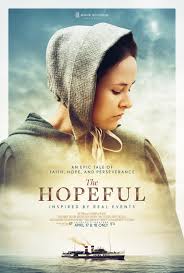
THE HOPEFUL
US, 2024, 90 minutes, Colour.
Tommie-Amber Pirie, Gregory Wilson, Maddy Martin, Bill Lake, Michael Mancini.
Directed by Kyle Portbury.
The Hopeful is a religious film, a film tracing the origins of the Seventh Day Adventist Church. While the film has its own audience, the directors, Kyle Portbury, with many Australian connections, pointing out that there are 22 million Adventistss around the world, in many countries, he hopes that the film will tell a story to a wider audience. He characterises this story as one failure but one of hope and belief.
For Christians, watching the film and discussing it, can be an exercise in ecumenism, discussing faith, discussing beliefs, interpreting the Bible… Since The Hopeful is getting a wide release in Australian Cinemas, this discussion is relevant. And many will remember the Adventist connections in Australian cinema, Bob Ellis, a prolific writer and commentator, remembering his upbringing in The Nostradamus Kid as well as the story of the Chamberlains and the film version, Evil Angels.
Because this is a straightforward telling of the story, enthusiastically made by the writers and the director and an earnest cast, it is the kind of film that can be easily dismissed by secular audiences who see no relevance in it. However, considering the ranges of churches and their large numbers of members, it has its historical relevance.
The framework of the film is an Adventist missionary on a paddle steamer recounting the story of the movement to his two children. As he tells the story, the narrative goes into flashbacks, beginning with a focus on William Miller, wounded in the war of 1812, religious, supported by very strong-minded wife, studying the Scriptures, from a very literal standpoint, working from numbers in various books, including the book of Daniel, deciding that the second coming of Christ was to be in 1844. He preached vigorously, found some followers and boaters, many walking away. When the physical second coming of Christ did not eventuate, he retired, and there were differing interpretations of how Christ would be coming into the world.
But, he had his supporters. He had a strong following in 1843 and some of them continued his mission, most especially Ellen Smith, 16, frail health, but something of a visionary over the decades, not dying until 1915, she was a promoter of Adventist faith, along with her husband. While the drama of the initial flashbacks focus on William Miller, more attention is given to Ellen Smith, movement against her by sceptics, her being accepted as a spokesperson, her marriage, her husband’s illness, her children, personal grief but continued commitment.
The sequences are filmed with a sense of authenticity, costumes, décor, manners, New England atmosphere, well-mannered, devout – reminiscent one might say of the atmosphere of Little Women.
Particularly striking is the sequence of the meeting where discussion focuses on the name of the group, their interpretation of Saturday as the seventh day of rest, and their eagerness for the coming of Christ, and the agreement on Adventist in their name.
The film is a morale boost for Adventist audiences. An opportunity for other Christians to learn something about the church, it is emerging in 19th-century America, reflect on its beliefs and discuss its very literal interpretations of the Bible, especially in light of scholarship over the last 200 years.